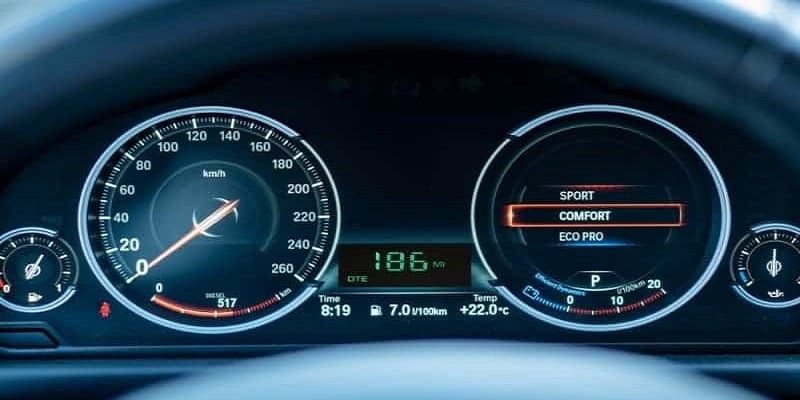Dte, in a car, stands for distance to empty. It is an indicator on the dashboard that tells you how far your vehicle can go on the remaining fuel.
This information can be helpful for drivers while planning their trips, especially on long journeys when refuelling options can be limited. It is important to note that the dte reading is an estimate and can vary based on driving conditions, fuel quality, and other factors.
In some cars, the dte reading is calculated based on the average fuel consumption rate, while in others, it may depend on the fuel tank level. In this article, we will delve deeper into what distance to empty means in your car and how it works.

Credit: www.crainsdetroit.com
Understanding The Basics Of Dte
If you’re a car owner, you might have seen the acronym “dte” on your vehicle’s dashboard. Do you know what it means? Dte stands for “distance to empty,” which is the estimated distance that your car can travel before the fuel tank is empty.
This metric is crucial in ensuring that you don’t run out of gas unexpectedly.
Definition Of Dte
Dte, or distance to empty, is a metric that is calculated by your car’s internal computer. Using data from various sensors in the vehicle, the computer estimates the amount of fuel left in the tank and calculates how far you can travel before running out of gas.
This calculation is then displayed on the dashboard, alerting the driver of the estimated distance left before refueling is required.
The History And Evolution Of Dte
The evolution of dte is directly related to advancements in automotive technology. Early cars had simple fuel gauges that only indicated the amount of fuel left in the tank. It wasn’t until the 1970s that some car models began to display the estimated distance to empty.
With the evolution of computer sensors and computing power, today’s modern cars can accurately calculate the distance to empty with more precision than ever before.
The Importance Of Dte In Modern Cars
In modern cars, dte has become an essential metric that drivers rely on. It helps prevent unexpected breakdowns and assists with route planning. Long gone are the days of driving around, hoping to find a gas station before running out of fuel.
With dte, drivers have a clear idea of how far they can go before needing to refuel. This is especially crucial on long road trips, where the next gas station might be hundreds of miles away.
Understanding the basics of dte is essential for any car owner. Don’t let yourself be caught off guard by a sudden empty fuel tank. With distance to empty, you can take control of your route planning and travel with confidence that you won’t be stranded without gas.
How Does Dte Work In A Car?
Dte stands for “distance to empty,” and it’s a feature found in most new vehicles. It’s designed to help drivers estimate how much longer they can drive before they run out of gas. Dte is shown on the vehicle’s dashboard and can be a lifesaver for drivers who find themselves running low on fuel.
We’ll explore how dte works in a car, what factors determine dte, and how accurate it is.
The Mechanism Of Dte
Dte calculations are based on the distance driven and the fuel remaining in the gas tank. The computer system in your vehicle takes the average fuel consumption over a set distance and uses that information to estimate how far you can drive with the remaining gas.
This is why the dte display changes as you drive; it’s continually recalculating based on your current driving conditions.
What Factors Determine Dte?
There are several factors that can affect the dte calculation. Here are some of the most important ones:
- Fuel consumption: The dte calculation is only as good as the accuracy of the average fuel consumption estimate. This estimate is based on previous driving patterns, so it can be inaccurate if your driving pattern changes.
- Driving conditions: Dte can be affected by driving conditions such as speed, terrain, and weather. Driving at high speed or uphill can reduce your fuel economy and lower the dte estimate.
- Fuel type: The type of fuel you use can also affect the dte calculation. For example, if you switch from regular to premium gas, you might notice that your dte estimate changes.
- Gas tank size: The size of your gas tank can affect the dte calculation. A larger gas tank will generally result in a higher dte estimate.
How Accurate Is Dte?
Dte is an estimate, so it’s not always 100% accurate. However, the accuracy of the dte display can vary depending on the vehicle. Some vehicles have very accurate dte displays, while others are less reliable. The accuracy of the dte display can also be affected by the factors we discussed earlier.
In general, it’s a good idea to treat the dte display as a rough estimate and not rely on it entirely. Always keep an eye on your fuel gauge and make sure you fill up before you get too low on gas.
Dte is a handy feature that can help you avoid running out of gas. While it’s not always 100% accurate, it’s still a useful tool for estimating how far you can drive with the fuel you have remaining. By understanding how dte works and what factors can affect the calculation, you can use it to your advantage and make sure you never get stranded on the road.
Practical Applications Of Dte
Have you ever noticed the dte indicator on your car’s dashboard and wondered what it meant? Dte stands for distance to empty, which displays the estimated distance a vehicle can travel until the fuel tank is empty. Knowing the dte value can be beneficial for drivers in many ways.
We’ll explore the practical applications of dte, how to calculate it, why it’s important to keep track of it, and tips on maximizing its use.
How To Calculate Dte?
Calculating dte is a simple process that anyone can perform. To determine the distance to empty, follow the steps below:
- Fill up the fuel tank fully
- Take note of the distance your vehicle has traveled since the last fuel up.
- Start your car and reset the trip counter.
- As you drive, take note of the dte value displayed on the dashboard.
- When you’re running low on fuel, fill up the tank again, and note the number of liters or gallons of fuel added.
- Divide the total number of liters or gallons added to the tank by the fuel consumption rate, which is the distance traveled divided by the amount of gas used.
- The result will be the average distance per liter or gallon of fuel, which you can use to calculate your vehicle’s dte.
Why Is It Important To Keep Track Of Dte?
Keeping track of dte can prevent drivers from being caught off-guard by an empty gas tank. By knowing the estimated distance a vehicle can travel, drivers can plan their routes accordingly and avoid running out of gas in the middle of nowhere.
Additionally, keeping track of dte can help drivers save both time and money. By filling up before the gas tank reaches empty, drivers can avoid waiting in long lines at gas stations and often save money by filling up at a cheaper price.
Tips On How To Maximize The Use Of Dte.
Here are some tips on how to maximize the use of dte and make the most out of every drop of gasoline.
- Avoid idling your engine unnecessarily as this wastes fuel.
- Drive at a consistent speed and avoid rapid acceleration and sudden braking.
- Remove any excess weight from your car, as carrying extra weight decreases fuel efficiency.
- Make sure your tires are properly inflated, as under-inflated tires can decrease fuel economy.
- Use cruise control on the highway to maintain a consistent speed and save fuel.
- Keep up with regular vehicle maintenance, as a well-maintained engine is more fuel-efficient.
Understanding dte and knowing how to calculate it, why it’s important to keep track of it, and tips on maximizing its use can help drivers save time, money and avoid unnecessary stress and inconvenience. Keep an eye on the dte value on your car’s dashboard and plan accordingly to ensure a smooth and efficient driving experience.
Frequently Asked Questions Of What Does Dte Mean In A Car?
What Is Dte In A Car?
Dte means “distance till empty” and refers to the estimated number of miles a car can travel before its fuel tank empties.
How Accurate Is Dte?
Dte is an estimate based on factors like fuel consumption rate, driving style, and road conditions. It’s generally accurate but can vary.
Does Dte Rely On Fuel Gauge?
Yes, dte relies on fuel gauge readings to estimate the distance a car can travel till empty.
Can Dte Help Improve Fuel Efficiency?
Yes, using dte feature can help drivers conserve fuel by adjusting driving habits, planning trips, and reducing idling time.
What If Dte Is Not Available In My Car?
If dte is not available, drivers can use the distance-to-empty formula or common sense to estimate how far their car can go before running out of fuel.
Conclusion
If you have made it this far, you should now have a good grasp of dte and know what it means in a car. Understanding your car’s dte is essential for planning your long drives and avoiding the inconvenience of running out of fuel.
It’s crucial to remember that this number is just an estimate and can vary depending on various circumstances, such as driving style, terrain, and traffic. Therefore, it’s best to err on the side of caution and not push your car’s dte to its limit.
Before setting off on your next journey, it’s always a good idea to check your fuel gauge and fill up your tank appropriately. Overall, dte is an essential feature in modern cars that provides much-needed peace of mind to drivers and navigation systems.







